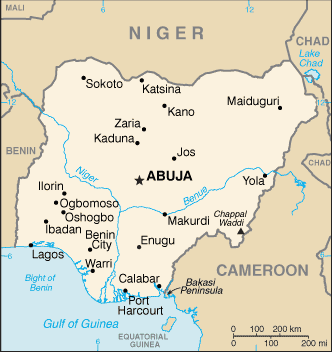| Nigeria |
|
|
 |
|
| Geography | |
| Location: | Western Africa, bordering the Gulf of Guinea, between Benin and Cameroon. |
| Area: | total:
923,768 sq km land: 910,768 sq km water: 13,000 sq km |
| Natural Resources: | natural gas, petroleum, tin, iron ore, coal, limestone, niobium, lead, zinc, arable land |
| Population and Health | |
| Population: | 177,155,754 (July 2014 est.) |
| Age structure: | 0-14 years: 43.2% (male 39,151,304/female 37,353,737) |
| Population growth rate: | 2.47% (2014 est.) |
| Birth rate: | 13.16 deaths/1,000 population (2014 est.) |
| Death rate: | 16.31 deaths/1,000 population (July 2010 est.) |
| Sex ratio: | at birth: 1.06 male(s)/female |
| Infant mortality rate: | total: 74.09 deaths/1,000 live births |
| Life expectancy at birth: | total population: 52.62 years |
| Total fertility rate: | 5.25 children born/woman (2014 est.) |
| Current contraceptive use among married women 15-49 years old(any method): | 15% (2007-2012) |
| Unmet need of contraceptive: | 18.9% (2011) |
| HIV/AIDS - people living with HIV/AIDS: | 3,426,600 (2012) |
| HIV/AIDS - deaths: | 239,700 (2012) |
| Literacy: | definition: age 15 and over can read and write |
| Economy | |
| GDP (purchasing power parity): | $478.5 billion (2013 est.) |
| GDP (official exchange rate): | $292 billion (2013 est.) |
| GDP - real growth rate: | 6.2% (2013 est.) |
| GDP - per capita (PPP): | $2,800 (2013 est.) |
| GDP - composition by sector: | agriculture: 30.9% |
| Labor force - by occupation: | agriculture: 70% |
| Population below poverty line: | 70% (2010 est.) |
| Inflation rate (consumer prices): | 8.7% (2013 est.) |
| Agriculture - products: | cocoa, peanuts, palm oil, corn, rice, sorghum, millet, cassava (tapioca), yams, rubber; cattle, sheep, goats, pigs; timber; fish |
| Industries: | crude oil, coal, tin, columbite; rubber products, wood; hides and skins, textiles, cement and other construction materials, food products, footwear, chemicals, fertilizer, printing, ceramics, steel |
| Industrial production growth rate: | 0.9% (2013 est.) |
| Exports - commodities: | petroleum and petroleum products 95%, cocoa, rubber |
| Currency (code): | naira (NGN) |
| Fiscal year: | calendar year |
| Others | |
| Nationality: | noun:
Nigerian(s) adjective: Nigerian |
| Religions: |
Muslim 50%, Christian 40%, indigenous beliefs 10% |
| Languages: |
English (official), Hausa, Yoruba, Igbo (Ibo), Fulani |
| Country name: | conventional
long form: Federal Republic of Nigeria conventional short form: Nigeria |
| Government type: | federal republic |
| Capital: | name:
Abuja geographic coordinates: 9 12 N, 7 11 E time difference: UTC+1 (6 hours ahead of Washington, DC during Standard Time) |
| Administrative divisions: | 36 states and 1 territory*; Abia, Adamawa, Akwa Ibom, Anambra, Bauchi, Bayelsa, Benue, Borno, Cross River, Delta, Ebonyi, Edo, Ekiti, Enugu, Federal Capital Territory*, Gombe, Imo, Jigawa, Kaduna, Kano, Katsina, Kebbi, Kogi, Kwara, Lagos, Nassarawa, Niger, Ogun, Ondo, Osun, Oyo, Plateau, Rivers, Sokoto, Taraba, Yobe, Zamfara |
| Independence: | 1 October 1960 (from UK) |
| Legal system: | based on English common law, Islamic law (in 12 northern states), and traditional law; accepts compulsory ICJ jurisdiction, with reservations |
|
|
|
| Source : UN_Demographic and Health Surveys (DHS), Multiple Indicator Cluster Surveys (MICS) and other national surveys; United Nations Population Division Update date: August 2014
|
|